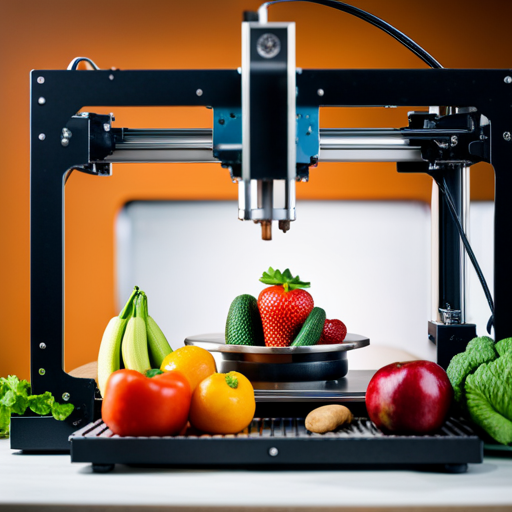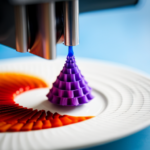In the evolving landscape of nutrition, the intersection of technology and dietary needs has given rise to the innovative concept of custom nutrition and food 3D printing.
This groundbreaking approach offers a tailored solution to individual dietary requirements, leveraging the potential of 3D printing to create personalized meal plans, nutrient-dense foods, and even customized vitamin and supplement options.
The convergence of nutrition and cutting-edge technology holds promising implications for the future of personalized dietary solutions.
The Rise of Custom Nutrition
The rise of custom nutrition has been driven by advances in personalized health and wellness approaches. As individuals increasingly seek tailored solutions to their dietary needs, custom nutrition trends have emerged as a response to this growing demand. Personalized food manufacturing, enabled by technological innovations such as 3D printing, has revolutionized the way nutritional products are created and consumed.
Custom nutrition trends reflect a shift towards individualized dietary regimens, acknowledging that a one-size-fits-all approach to nutrition may not be optimal for everyone. This has paved the way for the development of personalized food manufacturing techniques, which allow for the creation of nutritionally tailored products based on an individual’s specific requirements. 3D printing, in particular, has played a pivotal role in this field, offering the ability to produce intricate food structures with precision and efficiency.
The intersection of custom nutrition and personalized food manufacturing represents a paradigm shift in the way dietary needs are addressed. By leveraging technological advancements, the industry is poised to continue evolving, offering increasingly tailored and effective nutritional solutions to consumers.
Benefits of Food 3D Printing
Food 3D printing offers the potential for enhanced nutrition personalization, allowing for the precise control of nutrient content and portion sizes to meet individual dietary needs.
Additionally, this technology has the capability to significantly reduce food waste by utilizing ingredients more efficiently and creating custom food products on demand.
These benefits not only align with the growing demand for personalized nutrition but also contribute to sustainability efforts within the food industry.
Enhanced Nutrition Personalization
With 3D printing technology, personalized nutrition can be precisely tailored to individual needs and preferences, revolutionizing the way we approach dietary requirements. This level of personalization allows for the creation of tailored, nutrient-dense meals that align with specific dietary goals, allergies, and health conditions.
Precision nutrition, achieved through food 3D printing, enables the exact control of ingredient composition and portion sizes, ensuring optimal nutrient intake for each individual. By customizing the nutritional content of meals, food 3D printing can support personalized diets, such as those required for athletes, individuals with metabolic disorders, or those following specialized dietary regimens.
Furthermore, this innovative approach to food production has the potential to enhance compliance with dietary guidelines and improve overall health outcomes by providing individuals with the precise nutrients they need.
Reduced Food Waste
Utilizing 3D printing technology in food production minimizes wastage, a beneficial outcome for both environmental sustainability and cost efficiency. This innovative technology offers sustainable solutions to the global issue of food waste through the following ways:
-
Precise Ingredient Measurement: 3D food printing allows for accurate dispensing of ingredients, reducing the likelihood of overpouring or excess usage, thus minimizing food waste during the production process.
-
Customizable Portions: With the ability to create personalized food items, 3D printing enables portion control tailored to individual needs, preventing overproduction and subsequent wastage of uneaten food.
-
Extended Shelf Life: The layer-by-layer approach of 3D printing can create foods with optimized textures and structures, enhancing their shelf life and reducing spoilage, contributing to a reduction in overall food waste.
This demonstrates how 3D food printing presents a compelling solution for addressing food waste while also aligning with sustainable practices.
Personalized Vitamin and Supplement Options
As individuals seek personalized nutrition solutions, the integration of 3D printing technology allows for the creation of customized vitamin and supplement options. This innovative approach enables the development of customizable formulations tailored to an individual’s specific dietary and nutritional needs. Through 3D printing, it is possible to create supplements with personalized dosages, ensuring that individuals receive the precise amount of each nutrient required for their unique health requirements.
Customizable formulations offer the advantage of addressing specific deficiencies or health concerns, providing a targeted approach to supplementation. By leveraging 3D printing technology, manufacturers can produce supplements that contain a tailored combination of vitamins, minerals, and other essential nutrients, catering to the distinct needs of each person. This level of personalization has the potential to revolutionize the way individuals approach their nutritional intake, moving away from generic, mass-produced supplements towards a more precise and effective supplementation strategy.
Moreover, personalized dosages made achievable through 3D printing enable individuals to receive the exact amount of each nutrient necessary for their well-being, optimizing the effectiveness of supplementation while minimizing unnecessary intake. As the demand for personalized nutrition continues to grow, the integration of 3D printing in creating customized vitamin and supplement options offers a promising solution for meeting individual dietary requirements.
Tailored Meal Plans and Diets
Tailored meal plans and diets are essential components of personalized nutrition, offering individuals the opportunity to receive dietary recommendations and customized meal preparation based on their unique needs.
By tailoring meal plans and diets to specific nutritional requirements and preferences, individuals can optimize their health and wellness through targeted food choices.
This innovative approach to nutrition ensures that individuals receive the precise nutrients and energy levels needed to support their overall well-being.
Personalized Dietary Recommendations
The personalized dietary recommendations aim to provide individuals with tailored meal plans and diets based on their specific nutritional needs and health goals. This personalized approach offers several benefits, including:
-
Customized Meal Delivery: Individuals can have their personalized meals conveniently delivered to their doorstep, ensuring they adhere to their tailored dietary plans without the hassle of meal preparation.
-
Personalized Nutrition Coaching: In addition to personalized meal plans, individuals also receive guidance from nutrition coaches who provide ongoing support, education, and adjustments to their dietary recommendations based on their progress and changing needs.
-
Advanced Nutritional Analysis: Utilizing innovative technology, such as artificial intelligence and data analytics, enables a more accurate and comprehensive analysis of individuals’ nutritional requirements, resulting in highly tailored and effective dietary recommendations.
Transitioning into the subsequent section about ‘customized meal preparation,’ these personalized dietary recommendations lay the foundation for customized meal preparation methods that align with individuals’ specific nutritional needs and preferences.
Customized Meal Preparation
Building on the personalized dietary recommendations, this customized meal preparation approach focuses on tailoring meal plans and diets to individuals’ specific nutritional needs and preferences.
Meal customization involves the use of advanced algorithms and nutritional analysis to create personalized meal plans that consider factors such as dietary restrictions, allergies, cultural food preferences, and fitness goals.
By leveraging technology and data-driven insights, this approach ensures that individuals receive meals that are not only nutritionally balanced but also enjoyable and aligned with their lifestyle.
Additionally, the incorporation of dietary preferences into meal planning allows for a more sustainable and satisfying dietary experience, ultimately promoting long-term adherence to healthy eating habits.
Furthermore, this tailored approach can be particularly beneficial for individuals with specific health conditions or dietary requirements, providing a more precise and effective means of meeting their nutritional needs.
Nutrient-Dense 3D Printed Foods
Creating nutrient-dense 3D printed foods requires precise calibration of ingredient composition and printing parameters to ensure optimal nutritional content and taste. This innovative approach to food production allows for the creation of nutrient-rich culinary creations that cater to specific dietary needs and preferences.
Here are three key considerations in the development of nutrient-dense 3D printed foods:
-
Ingredient Selection: Careful selection of ingredients is crucial to ensure the final product is packed with essential nutrients. This involves sourcing high-quality, nutrient-rich ingredients to be used in the 3D printing process.
-
Nutritional Balance: Utilizing advanced nutritional analysis tools, food technologists can precisely calibrate the nutrient content of 3D printed foods to meet specific dietary requirements. This ensures that the final product is not only flavorful but also nutritionally balanced.
-
Texture and Taste Optimization: Achieving an optimal texture and taste in 3D printed foods is essential to ensure consumer acceptance. Through innovative techniques such as layering and texturizing, food technologists can create foods with appealing textures and flavors, enhancing the overall dining experience.
Future Implications and Possibilities
One potential implication of custom nutrition and food 3D printing is the expansion of personalized dietary solutions in the healthcare industry. This technology allows for the creation of specific nutrient combinations tailored to individual needs, potentially revolutionizing the way dietary requirements are met for patients with unique nutritional needs.
However, the future implications and possibilities of custom nutrition and food 3D printing also raise important ethical considerations. As this technology becomes more advanced and widespread, questions surrounding equitable access to personalized nutrition and the potential for creating further disparities in healthcare must be addressed.
Additionally, the environmental impact of food 3D printing is a crucial factor to consider. The use of 3D printing in food production has the potential to reduce food waste and optimize the use of resources, but it is essential to assess its overall environmental footprint, including the energy consumption and waste generated in the process.
As custom nutrition and food 3D printing continues to evolve, it is imperative to carefully examine and navigate the ethical and environmental implications to ensure its responsible and sustainable integration into the healthcare and food industries.
Frequently Asked Questions
How Does 3D Printing Technology Actually Work to Create Customized Nutrition and Food Products?
3D printing technology uses a layer-by-layer additive manufacturing process to create customized products. This involves precise material selection and deposition, allowing for the production of intricate and personalized nutrition and food items tailored to specific dietary needs and preferences.
Are There Any Potential Drawbacks or Limitations to Using 3D Printing for Personalized Nutrition and Food?
Examining the potential drawbacks and technological limitations of 3D printing for personalized nutrition and food highlights ethical concerns and considerations about consumer acceptance. The complex interplay of these factors necessitates a thorough evaluation of this innovative technology.
What Are the Cost Implications of Using 3D Printing for Personalized Nutrition Compared to Traditional Methods?
When considering the cost implications of using 3D printing for personalized nutrition compared to traditional methods, it is essential to assess the cost efficiency and market competitiveness. This requires a thorough analysis of production, materials, and scalability.
How Do Regulatory Bodies Oversee and Ensure the Safety and Quality of 3D Printed Food and Nutrition Products?
Regulatory bodies ensure the safety and quality of 3D printed food and nutrition products through stringent oversight, focusing on food safety, quality assurance, and technology processes. They address printing limitations and assess cost, environmental sustainability, and personalized nutrition implications.
What Are the Environmental Impacts of Using 3D Printing for Personalized Nutrition and Food Production?
The environmental impact of 3D printing for personalized nutrition and food production raises sustainability concerns due to its energy consumption, waste generation, and material sourcing. Analyzing these impacts is crucial for informed decision-making in this innovative field.
Conclusion
In conclusion, the intersection of custom nutrition and food 3D printing holds great potential for revolutionizing the way we approach dietary needs.
The ability to create personalized vitamin and supplement options, tailored meal plans and diets, and nutrient-dense 3D printed foods opens up a world of possibilities for optimizing individual health and wellness.
As the adage goes, ‘you are what you eat,’ and with advancements in this field, the future of nutrition looks promising.


